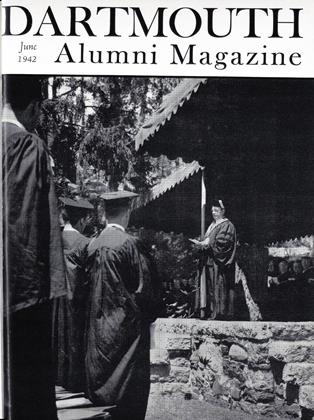Suggestions of Dr. Groves Provide a Basis for an Ever-Greater Understanding and Interest Between Family and Church
byErnest R. Groves '03. Macmillan, 1942, 229 pp., $2.00.
CHRISTIANITY AND THE FAMILY is an amplified, book-form version of the Rauschenbusch Lectures, which Dr. Groves gave at the Colgate-Rochester Divinity School in the Spring of 1941. The author, who is Professor of Sociology at the University of North Carolina, has been for many years an authority in the field of American home and family life. He is especially well-known for his pioneering work in education for marriage and marriage counseling.
According to the Preface, this book is "a plea to the Protestant ministry for a more practical, understanding interest in the family and a greater appreciation of its relation to Christianity." Lest this statement seem to establish a ministerial monopoly, it should be said that most of what Dr. Groves has to say will be of equal interest and value to laymen and deserves their attention.
The first part o£ the book, "The Family As an Ally of Christianity," may be summarized briefly as follows: family relationships are inherently spiritual; therefore, the family is by its very nature a potential partner of Christianity. Jesus realized this fact, making the experiences and relationships of the family the chief clue to the nature of God and His Kingdom, and using the language of family life as the basis of much of His teaching. How- ever, the present contribution of the family to Christianity is hampered by many adverse conditions, both social and psychological.
The second part of the book, "The Church as an Ally of the Family," is a development of Dr. Groves' thesis that the church and its ministers can do much to reclaim the family for their spiritual ally and at the same time help the individuals in whose welfare they are supposed to be primarily interested. Valuable suggestions for an adequate program of education in the major relationships of family life are given, and there are four chapters on the art of "domestic counseling" which every minister and, indeed, every person who is engaged in counseling of any kind should find extremely helpful. The illustrations given in this section on counseling are so illuminating that some readers may regret that more such material was not included: a complete bibliography makes up in some measure for any deficiency at this point. REV. CHESTER B. FISK.
 View Full Issue
View Full Issue
More From This Issue
-
 Article
ArticleCollege Graduates Return
June 1942 -
 Class Notes
Class Notes1927 Has Its Quindecennial
June 1942 By DOANE ARNOLD '27 -
 Class Notes
Class Notes1937 Holds Its Fifth Reunion
June 1942 By JOHN H. DEVLIN JR. '37 -
 Class Notes
Class Notes'Seventeen's Silver Jubilee Wins Cup
June 1942 By MOTT D. BROWN JR. '17 -
 Article
ArticleValedictory to Class of 1942
June 1942 -
 Article
ArticleFirst War Class Graduates
June 1942
Books
-
 Books
BooksTHE BEASTS & THE ELDERS.
January 1974 By ALEXANDER G. MEDLICOTT JR. '50 -
 Books
BooksTHE LAOTIAN FRAGMENTS.
October 1974 By DAVID BOWMAN '63 -
 Books
BooksDON'T COME CRYING TO ME.
February 1955 By HERBERT F. WEST '22 -
 Books
BooksTHE BULLS AND THE BEARS: HOW THE STOCK EXCHANGE WORKS.
DECEMBER 1967 By JOHN HURD '21 -
 Books
BooksWAGON WHEELS: A STORY OF THE NATIONAL ROAD.
November 1956 By MARCUS A. MCCORISON -
 Books
BooksLIQUIDITY AND STABILITY
January 1941 By Ray V. Leffler

